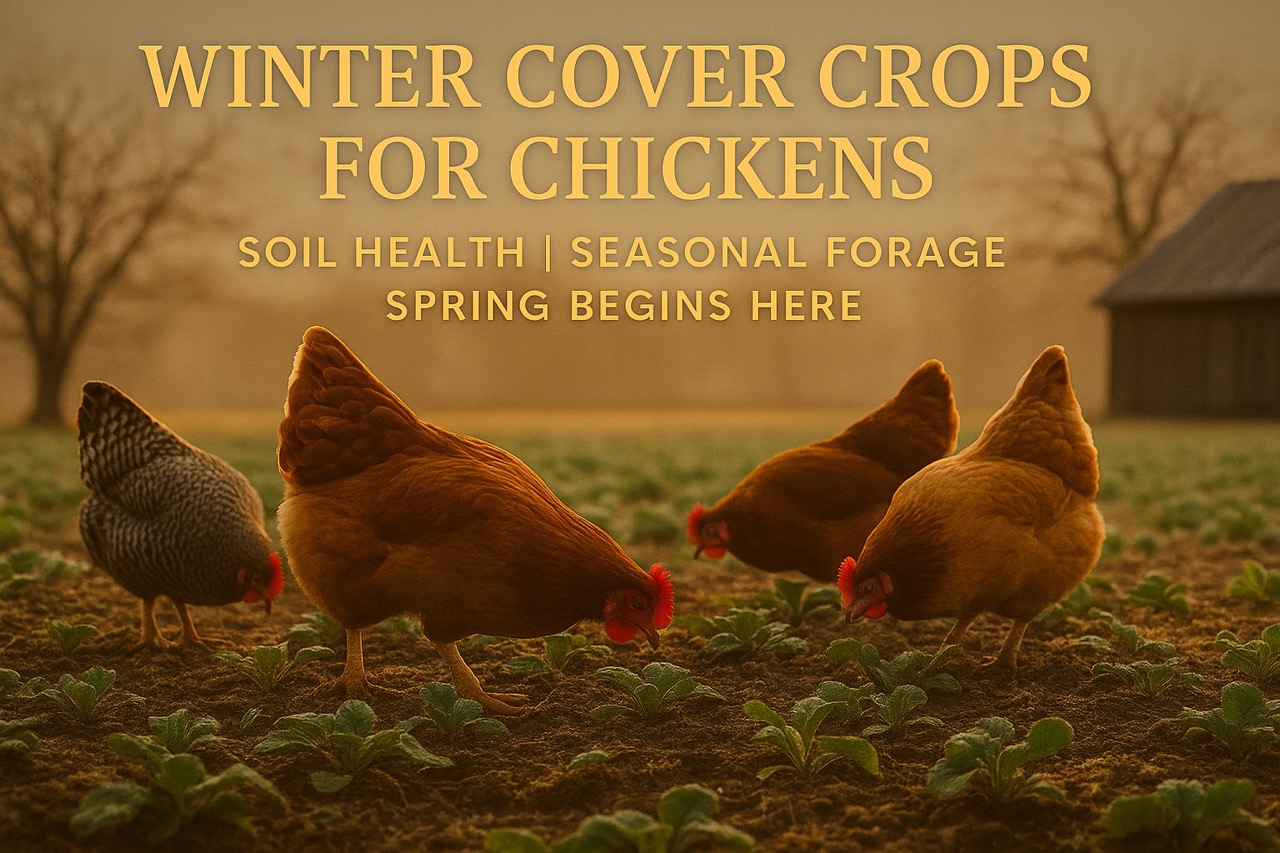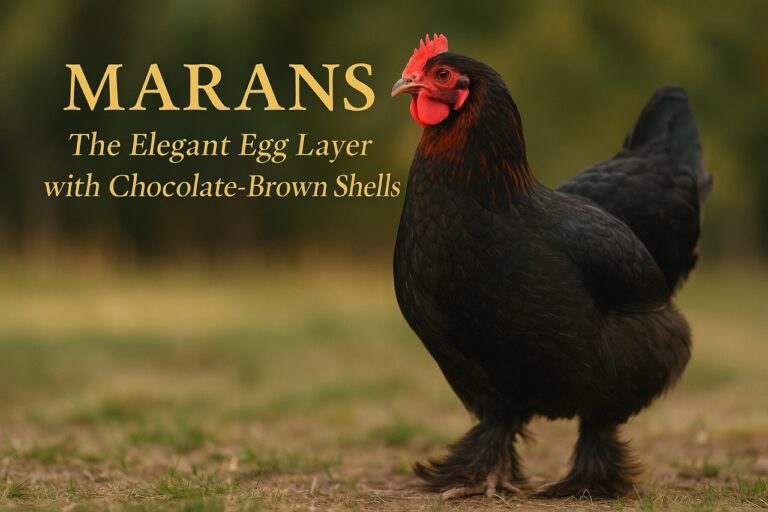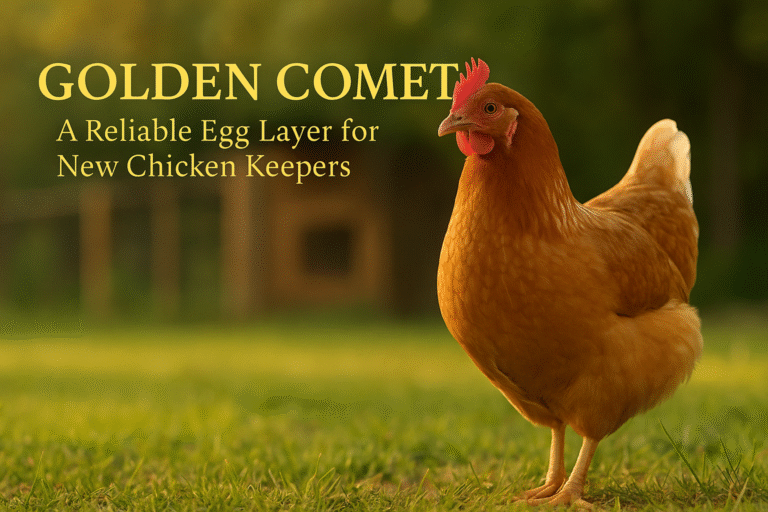Planting winter cover crops for chickens isn’t just good gardening—it’s regenerative stewardship. These crops nourish your soil, reduce winter erosion, and provide fresh seasonal forage for your backyard flock when greens are scarce.
Whether you’re working a Southeastern homestead or tending a modest backyard plot, cover crops transform your winter ground into a living system that feeds both your chickens and the land beneath their feet.
🌱 The Core Benefits of Winter Cover Crops
1. Soil Enrichment and Fertility
Certain cover crops—like crimson clover, Austrian winter peas, and vetch—are nitrogen-fixing plants. They pull nitrogen from the air and store it in the soil, naturally fertilizing your spring garden without synthetic inputs.
Other crops like daikon radish send deep taproots into the soil, breaking up hardpan and improving water infiltration. As crops like winter rye decompose, they leave behind rich organic matter and a more resilient soil structure.
2. Weed Suppression and Erosion Control
Bare soil in winter is vulnerable. Rain and runoff can quickly wash away topsoil, especially in the Southeast. But cover crops form a protective root web that holds your soil in place.
Their leafy growth also acts as a living mulch, shading out weed seeds and reducing the need for herbicides come spring.
3. Water Conservation
Alternating between heavy rainfall and dry spells, Southeastern winters can be extreme. Cover crops help balance this by covering the soil and slowing evaporation, keeping your garden hydrated and stable during unpredictable weather.
4. Spring Garden Readiness
When spring comes, winter cover crops can be mowed or tilled into the soil as green manure—boosting nitrogen, carbon, and microbial activity.
You’ll see healthier, more productive crops like tomatoes, squash, and peppers. And because cover crops improve drainage and soil texture, your spring plants will root more deeply and draw up nutrients more efficiently.
🐔 Winter Cover Crops as Chicken Forage
Cover crops can also serve your chickens by providing fresh greens and mental stimulation during winter’s lean months.
1. Seasonal Forage Boost
Chickens naturally forage for greens, bugs, and seeds. When snow or mud makes that harder, cover crops like ryegrass, clover, and winter peas offer a protein-rich alternative.
They encourage natural pecking and scratching, support better digestion, and add variety to a winter diet that might otherwise be dry or boring.
2. Supplementing—Not Replacing—Feed
While chickens love cover crops, these plants shouldn’t replace balanced layer feed. Think of them as a nutritious bonus—a way to reduce feed consumption by 15–30%, depending on how often your chickens graze.
Your flock still needs a complete ration of protein, calcium, and minerals for optimal egg laying and health.
3. Try Rotational Grazing
Want to make your cover crops last longer? Rotate your chickens through planted sections instead of letting them access the entire area at once.
This allows the crops to regrow between grazing periods and prevents over-foraging—similar to pasture management in larger-scale agriculture.
4. Enhancing Free-Range Diets
If your chickens roam beyond the cover crop area, they’ll find seeds, insects, and natural matter. Cover crops simply expand the foraging buffet—offering diversified nutrition and better resilience during the colder months.
🕰️ Why Fall Planting Sets Spring Up for Success
1. Builds Natural Fertility
Legumes like crimson clover and winter peas fix atmospheric nitrogen. By spring, the decomposing roots and foliage provide a slow-release fertilizer that helps eliminate dependency on synthetic chemicals.
2. Improves Soil Structure
Daikon radishes and winter rye break up compacted clay and loosen up sandy soils. This makes your garden more receptive to spring roots and supports deeper, stronger crop growth.
3. Reduces Pests and Weeds
Cover crops like mustard greens act as biofumigants, suppressing certain soil-borne pests and fungal pathogens. Their dense canopy also blocks sunlight from reaching weed seeds, cutting back on spring weeding time.
🌾 Best Winter Cover Crops for Chickens & Gardens
| Crop | Function | Chicken-Safe? |
|---|---|---|
| Crimson Clover | Nitrogen fixing | ✅ Yes |
| Austrian Winter Peas | Protein-rich forage | ✅ Yes |
| Winter Rye | Soil structure, green manure | ✅ Yes |
| Daikon Radish | Deep tillage, aeration | ✅ Yes |
| Ryegrass | Cold-hardy forage | ✅ Yes |
| Mustard Greens | Pest suppression | ✅ In moderation |
🌿 Practical Tips for Planting Winter Cover Crops
- Choose crops by need: Peas and clover for nitrogen; rye and radish for structure; mixes for overall balance.
- Plant 4–6 weeks before your first frost to allow crops to root before winter slows growth.
- Avoid letting them go to seed in spring—mow or turn them under before flowering.
- Use fencing or movable runs for chicken access if practicing rotational grazing.
Sources
- GardenersPath – How to Use Winter Cover Crops to Improve Soil
This resource provides an in-depth guide to selecting, planting, and utilizing winter cover crops to improve soil health and structure. It covers a range of cover crop species and explains their benefits in composting and nutrient cycling. - Epic Gardening – Fall Cover Crops: The Ultimate Guide
A comprehensive guide detailing the advantages of planting cover crops in the fall. This article focuses on how these crops prevent erosion, suppress weeds, and enrich the soil for the next growing season. - North Dakota State University – Planting Cover Crops Still Beneficial in Fall
This publication from NDSU emphasizes the value of cover crops even in challenging conditions, such as dry fall seasons. It includes practical advice for integrating cover crops into a sustainable farming or gardening plan. - Epic Gardening – Cover Crop Benefits
This article highlights the various benefits of using cover crops, including soil health improvement, moisture retention, and their role in organic gardening practices. It also provides tips for selecting the right cover crops for different climates and purposes.
🐓 Related Reading on Paranoid Prophet
- Wheatgrass Hay for Chickens – Winter Wellness and Enrichment
Discover how wheatgrass hay supports nutrition, behavior, and soil health when fresh forage is scarce. - Chicken Dust Baths: Essential for Your Flock’s Health
A complete guide to dust bathing, natural hygiene, and parasite prevention for backyard chickens. - Backyard Chickens and Sustainability
Learn how chickens contribute to a regenerative homestead by reducing waste and improving soil. - Chickens and Natural Pest Control
Explore how your flock can help control garden pests through natural behaviors—without chemicals. - Benefits of Raising Backyard Chickens
From fresh eggs to soil enrichment, this foundational article explores why chickens belong in every backyard ecosystem.
🧠 Frequently Asked Questions – Winter Cover Crops for Chickens
What are the best cover crops for chickens to eat?
Ryegrass, clover, Austrian winter peas, wheat, and oats are all safe and beneficial. Avoid plants like hairy vetch or any member of the nightshade family, which can be toxic.
Can winter cover crops replace commercial feed?
No. They should supplement feed, not replace it. While chickens love cover crop greens, they still require formulated feed to ensure complete nutrition.
How much can cover crops reduce feed costs?
Depending on flock size, foraging time, and crop density, you might save 15–30% on feed through the winter.
What’s the best time to plant cover crops?
Aim to plant 4–6 weeks before your region’s average first frost date so the crops establish before growth slows.
Can I plant cover crops in raised beds?
Yes! Raised beds are ideal for smaller homesteads. You can grow compact crops like clover or rye, then rotate chickens through them using chicken tractors or mobile fencing.
How do I stop chickens from destroying all my crops?
Rotational grazing is key. Divide the area into zones and rotate your flock every few days. This prevents overgrazing and lets the crops recover.
🌎 Final Thoughts: Stewardship in Every Season
Planting winter cover crops for chickens blends two sacred goals: soil restoration and flock resilience. What starts as simple ground cover becomes a cycle of nourishment—feeding your garden, blessing your chickens, and preparing the land for what comes next.
In a world of shortcuts and instant fixes, cover cropping is slow, intentional, and powerful. It reminds us that the best food systems begin underground—rooted in patience, covered in grace, and made whole through care.




